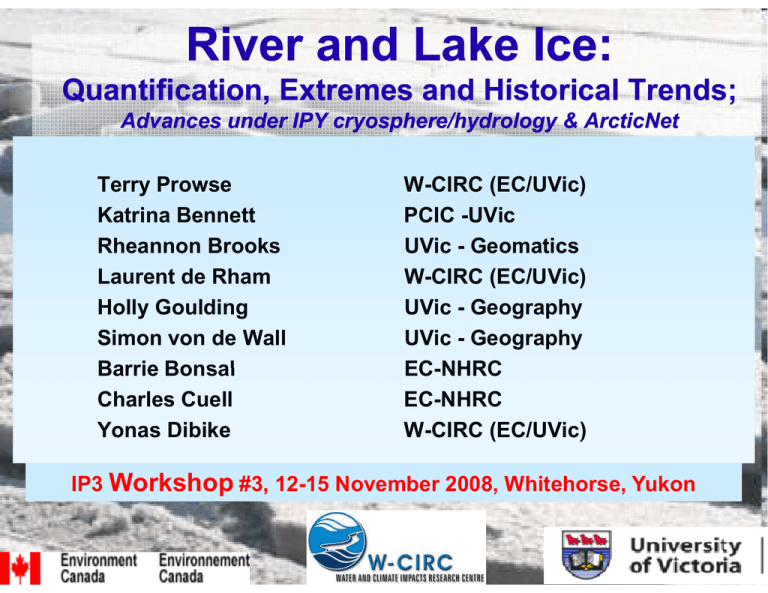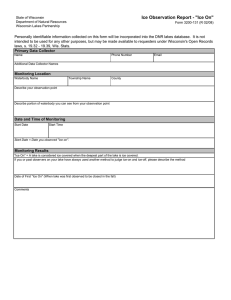River and Lake Ice:
advertisement

River and Lake Ice: Q Quantification, tifi ti Extremes E t and d Historical Hi t i l Trends; T d Advances under IPY cryosphere/hydrology & ArcticNet Terry Prowse Katrina Bennett Rheannon Brooks Laurent de Rham Holly Goulding Simon von de Wall Barrie Bonsal Charles Cuell Yonas Dibike W-CIRC (EC/UVic) PCIC -UVic UVic - Geomatics W-CIRC (EC/UVic) UVic - Geography UVic - Geography EC NHRC EC-NHRC EC-NHRC ( ) W-CIRC (EC/UVic) IP3 Workshop #3, 12-15 November 2008, Whitehorse, Yukon Outline 1 Quantification of Freshwater Ice: Areas and 1. Volumes in the Northern Hemisphere 2. River Ice and Hydrologic Extremes: Mackenzie River Basin 3. River Ice and Hydrologic Extremes: Mackenzie River Delta 4. Atmospheric Linkages 5. Lake Ice Phenology and Composition 1. Quantifying freshwater ice: area & volumes Issue: Of all cryospheric components: no estimates ti t exist i t as summarized by IPCC 2007 ¾ Required q to understand p past variability and future change ¾ From Lemke et al. 2007 Freshwater ice; lakes and rivers ?? - ?? ???? - ???? ???????? Objective: ¾ Quantify the spatial extent, extent distribution, distribution and volume of river ice across the Northern Hemisphere GIS river networks G idd d ttemperature Gridded t & 0C iisotherms th 0 to 15.0 days -7.5 to 0 -15.0 to -7.5 Methods: ¾ Analyzed using overlapping gridded temperature and river network data sets in GIS ¾ current (~last ½ century) river-ice extent and volumes were quantified ¾ Spatial p extent f: of 0°C isotherm for Jan, Oct-Mar & Annual air temp. p ¾ Volume: temperature index modelled using AFDD Results: ¾ 54, 46 and 54 d 27% off NH river i networks t k are iice affected ff t d in i th the coldest ld t month, th three-month and six-month periods ¾ Maximum Area covered by river ice in the Northern Hemisphere is 231 x103 km2. ¾ Peak Volume of river ice in the Northern Hemisphere is 120 km3 Future Research: ¾ ¾ ¾ Freshwater ice; rivers (NH) ; lakes (NH) 0.23 - ??? 0.00012 - ???? ????? Q Quantification of Northern Hemisphere p lake ice Examination of past trends/ variability Assessment of climate-change on future ice extent & volume ????? 2. River Ice: Hydrologic Extremes for the Mackenzie River Basin Issue: ¾ Virtually all break-up and ice jam flood studies are site-specific i ifi case studies di ¾ No quantification of spatial and temporal patterns of break-up season at the watershed scale Methods: ¾ ¾ ¾ Extraction and calculation of spring break-up break up variables (timing and magnitude) from WSC (19132002): Mann Kendall trend analysis (1970-2002) Mann-Kendall (1970 2002) Return Period assessment (HM and HO) Results: Last Timing B trend of HB Timinganalysis Trend Regime of classification events of events • south overall overall, ice effects to events north evident progression occurring at all locations earlier of break break-up up • 13/28 break-up sites duration dominated ~ 2 to by3ice months, eventsS-N (i.e. break-up flooding) • Earlier trend signal event stronger timing in upper in upstream Peacevs • River some downstream basin distinctlocations hydro-climatic regimes References: de Rham LP, Prowse TD, Bonsal BR. 2008a. Temporal variations in river-ice break-up over the Mackenzie River Basin, Canada. Journal of Hydrology 349: 441-454 de Rham LP, Prowse TD, Beltaos S, Lacroix MP. 2008b. Assessment of annual high-water events for the Mackenzie River basin, Canada. Hydrological Processes 22: 3864-3880 Conclusions and Future Research: ¾ B k Break-up d i t peak dominates k water t level l l events t ffor Mackenzie M k i b basin i ¾ Currently analyzing similar data across Canada to evaluate broader range off hydro-climatic h d li ti regimes; i eventually t ll circumpolar i l b beginning i i with ith R Russia i ? ¾ Also assessing physical and climate controls of regimes; further analysis will also evaluate effect of freeze-up levels on break-up – a variable likely to change with increasing climate-induced autumn flows ¾ Future goal to assess effects of changes in driving (e.g., flow) and resisting forces (e.g., ice thickness) under changing climatic conditions 3. River Ice: Hydrologic Extremes for the Mackenzie River Delta Objective: Characterization of ice break-up in the Mackenzie Delta ¾ emphasis on break-up patterns and hydro-climatic controls for extreme t events t 1) Create C t a chronology h l off b breakup k iin th the d delta, lt characterizing spatial and temporal patterns 2) Quantify basin-wide and intra-delta hydroclimatic controls and assess their influence on break-up break up timing & severity Snowpack p size,, rate of melt = Size and ‘shape’ of spring hydrograph Ice cover resistance = Ice thickness, strength, & support boundary conditions Results: ¾ ¾ Severity of break-up most influenced by upstream discharge related controls Timing most influenced by downstream ice Spatial Patterns: Increase (decrease) in peak water levels moving i northward th d through th h the th delta d lt for f discharge (ice) events Two extreme event types: Discharge-driven and ice-driven Temporal Patterns: Later (earlier) break-up in the delta for discharge (ice) events Conclusions: ¾ Spatial p and temporal p patterns of break-up p p associated with different types of high peak stage events: ice-driven and discharge-driven ¾ Break-up p severity y most influenced byy upstream p discharge, g but ice conditions also important ¾ Other Trend Analysis: y earlier break-up p trends, longer g p prebreak-up p melt interval and smaller upstream and downstream factors z more frequent occurrences of low peak stage events in the future? Future Research: ¾ Multi-variate analysis of factors affecting extreme events ¾ Quantification of upstream p controls,, i.e.,, basin snowpack p and trigger gg tributaries ¾ Relationship p of upstream p and downstream controls to large-scale g controls, i.e., mid-tropospheric synoptic patterns 4. Atmospheric Linkages Issue/Objective: ¾ ¾ Obtain better understanding of past & future climatic relationships with freshwater ice Synoptic typing of atmospheric circulation patterns associated with observed ice variability Methods: ¾ ¾ ¾ Synoptic typing of daily 500mb geopotential heights over northwestern th t C Canada d ffrom 1948 1948-2008. 2008 Assessment of synoptic patterns as they relate to cryospheric variabilityy and extremes Examination of long-term trends and variability in relevant synoptic types Results: ¾Cold northerly flow; types 10 11 12 10,11,12 ¾ Warm southerly flow, types 7 & 8 Synoptic Types: cold, cold warm and normal defined by linking with NCEP reanalysis of surface air temperature Frequency/Trends: trends leading to cold-season warming in the lower Mackenzie region, e.g., • warm arm 8 8: most common in fall and spring of cold season season; trend = +8.9d/60yr +8 9d/60 r • cold 10: exclusive to winter; -11d/60yr Future Research: ¾ Relating synoptic types to aforementioned observed ice extremes ¾ Continued assessment of past trends and variability in key synoptic types ¾ Relationships to large-scale teleconnections and circum-polar circulation features ¾ Assessment of changes to future synoptic types based on GCM/RCM data 5. Lake Ice Phenology and Composition Issue: ¾ How will climate change affects North American lake-ice phenology and composition at a continental scale? Objectives: ¾ ¾ Simulation of lake ice p phenology gy and composition p for current and future climate over North America Analysis of climate change impacts to ice (longer term: thermal structure aquatic habitat) structure, Methods: ¾ ¾ ¾ Simulate vertical distribution of lake water temperature and evolution of seasonal lake ice and snow cover using 1-D, process based model (MyLake) (Saloranta and Andersen, 2004) Inputs: Daily gridded air temperature, cloud cover, relative humidity, surface air pressure, wind speed and precipitation (from NARR 0.3o and CRCM 4.2/Class 2.7 0.4o data sets)) Conduct simulation using hypothetical lakes of 5m, 20m and 40m depths located at each 2o data grid point Results 72o N o Longitude Change Lake-Ice g in Thickness Maximum along Lake-Ice g 100Thickness g (days) ((m) ((m) ) ) Change Lake Lake-Ice Ice Break Break-Up Up dates Change ininLake-Ice Freeze-Up Change in Lake-Ice Cover Duration (in days) 40o N Julian Days CRCM-A2 Climate Change Scenario (2050s Vs 1970s) Results: ¾ Maximum lake-Ice thickness on average 10 to 30cm thinner in 2050s compared to 1970s ¾ Greater change in lake-Ice thickness at high latitudes ¾ Lake-ice break-up dates are earlier by around 10 to 20 days ¾ No significant difference in the future change in break-up dates with different lake depths ¾ Lake-ice freeze-up dates are delayed by up to 10 days ¾ Future change in freeze-up date is more significant for deeper lakes ¾ Lake-ice duration is decreased by around 15 to 35 days Conclusions: ¾ Future climate will result in reduction of lake ice thickness and ice cover duration ice-cover ¾ Lake depth has significant influence on ice thickness, phenology and composition ¾ Elevation and magnitude of precipitation have greater influence on lake ice composition p than latitudinal effects ¾ Relative increase in snow-ice thickness at northern latitudes may be attributed to increase in winter precipitation events Future Research: ¾ Extending the grid-based lake-ice simulation study with different climate inputs corresponding to different RCM models and emission scenarios ¾ Field verification of simulation results for lake ice phenology and composition Thank you! y




